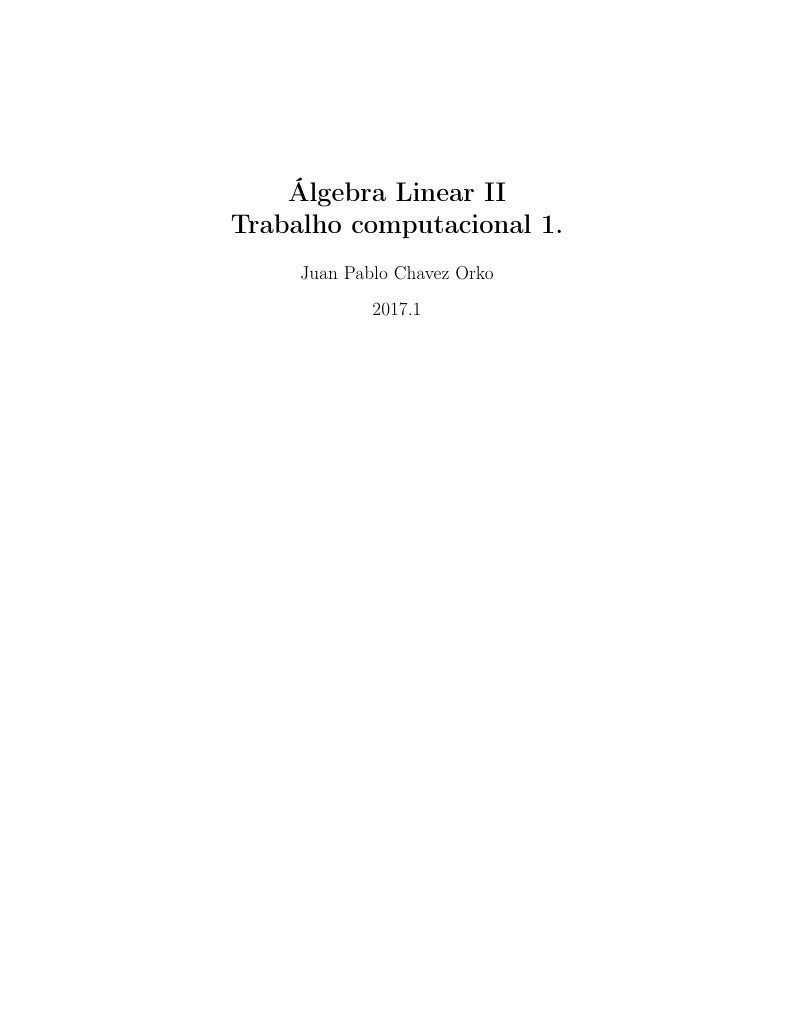
Álgebra Linear II

\documentclass[12pt]{article}
\usepackage[portuguese]{babel}
\usepackage[utf8x]{inputenc}
\usepackage[T1]{fontenc}
\usepackage{amsmath,amssymb,amsthm}
\usepackage{graphicx}
\usepackage{geometry}
\usepackage{tikz}
\pagestyle{empty}
\title{\textbf{Álgebra Linear II}\\ \textbf{Trabalho computacional 1.}}
\author{Juan Pablo Chavez Orko}
\date{2017.1}
\begin{document}
\maketitle
\thispagestyle{empty}
\newpage
\textbf{1)}Para resolver esta questão obtemos a matriz de links H como:
$$H=\begin{pmatrix}
0 & 0 & 0 & 0 & 0 & 0 & 1/3 & 0 \\
1/2 & 0 & 1/2 & 1/2 & 0 & 0 & 0 & 0 \\
1/2 & 0 & 0 & 0 & 0 & 0 & 0 & 0 \\
0 & 1 & 0 & 0 & 0 & 1/2 & 0 & 0\\
0 & 0 & 1/2 & 1/2 & 0 & 0 & 1/3 & 0\\
0 & 0 & 0 & 0 & 1/3 & 0 & 0 & 1/2\\
0 & 0 & 0 & 0 & 1/3 & 0 & 0 & 1/2\\
0 & 0 & 0 & 0 & 1/3 & 1/2 & 1/3 & 0
\end{pmatrix}$$
usamos a função eig para obtermos o vetor de importância
$$V^{T}=\begin{pmatrix}
-0.1161 & -0.3483 & -0.0580 & -0.5224 & -0.4063 & -0.3483 & -0.3483 & -0.4257
\end{pmatrix}$$
\textbf{2)}Vamos supor , por absurdo, que $\lambda = 1$ não e autovalor de uma matriz de links , ou seja, $det(H-1I) \neq 0.$ Seja $H=\begin{bmatrix}
h_{ij}
\end{bmatrix}_{n \text{x} n}$, note que cada coluna da matriz de links somam 1 e que a diagonal principal e composta por zeros.
$$\sum_{j=1}^{n}h_{ij}=1 \ \\\ \ H=\begin{pmatrix}
0 & * & * & \cdots & & *\\
* & 0 & * & \cdots & & *\\
\cdot & & \cdot & & & \cdot\\
\cdot & & &\cdot & & \cdot\\
\cdot & & & & \cdot & \cdot\\
* & \cdot & \cdot & \cdot & & 0
\end{pmatrix}$$
quando você faz a soma de $H - 1I$ vemos que a soma de cada coluna e zero, logo podemos escrever uma coluna como combinação linear das outras, com isso vemos que $H - I$ não e inversivel. Portanto $det(H-I)=0$ (absurdo), logo $\lambda=1$ e autovalor de H.
\\ \\\
\textbf{3)}Usando os algoritmos dos métodos da potência, potência inverso e potência inverso deslocado na matriz
$$A=\begin{pmatrix}
226 & -171 & 90 & -13 & 66\\
-171 & 162 & -15 & -13 & -57\\
90 & -15 & 284 & 32 & 8\\
-13& -13 &32 &55 &-16\\
66 & -57 & 8 & -16 & 128
\end{pmatrix}$$
obtemos os seguintes autovetores e $k$ iterações respectivamente
$$v_{1}=\begin{pmatrix}
1.0000\\ -0.7406\\ 0.6925\\ 0.0339\\ 0.3678
\end{pmatrix} k=33, \\\
v_{2}=\begin{pmatrix}
0.9025\\ 1.0000\\ -0.3074\\ 0.6444\\ 0.0794
\end{pmatrix} k=4,\\\
v_{3}=\begin{pmatrix}
-0.2048\\ 0.3331\\ 0.1350\\ -0.2889\\ 1.0000
\end{pmatrix} k=4$$
onde $v_{1}$ e associado ao maior autovalor, $v_{2}$ ao menor autovalor e $v_{3}$ ao autovalor mais proximo a $\alpha = 100$.
\textbf{4)}Para refazer a o exercício 1 vamos usar o método da potência, pois os outros metodo a necessidade de usar o inverso da matriz, e a matriz de links $H$ não e invertivel.
Vamos obter os seguintes resultados
$$V_{1}^{T}=\begin{pmatrix}
0.2222 & 0.6667 & 0.1111 & 1.0000 & 0.7778 & 0.6667 & 0.6667 & 0.8148
\end{pmatrix}$$
onde $V_{1}^{T}$ e autovetor associado a $\lambda = 1$, observe que $V_{1}^{T}$ é multiplo de $V^{T}$.
\end{document}